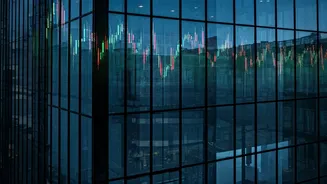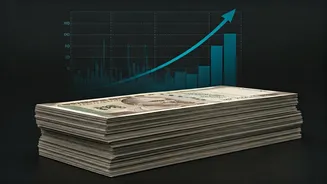Investment and Growth
Several companies recently announced substantial investments, indicating confidence in the Indian market. Hyundai Motor India plans to invest Rs 45,000
crore by the fiscal year 2030, signaling a strong commitment to the Indian market and its future growth. Additionally, Anant Raj raised Rs 1,100 crore through a share sale, which reflects investor interest in the real estate sector. Furthermore, the IMF has increased India's GDP forecast to 6.6% for the fiscal year 2026, highlighting positive economic growth expectations. This boost in economic forecasts can influence additional investment and market momentum. These developments suggest a positive outlook, driven by both domestic initiatives and global economic trends. These investments underscore the confidence companies have in India's economic prospects.
Market Performances
Stock markets have shown positive momentum, influenced by Asian cues and expectations of rate cuts. The performance of stock markets often reflects broader economic sentiments and investor confidence. Simultaneously, the passenger vehicle dispatches increased by 4% in September. Also, Maruti Suzuki experienced record bookings and strong festive sales, which indicates rising consumer demand and sector-specific growth. Conversely, the housing sales in top 8 cities dipped during the July-September period, indicating a varied market response. These varying performances point to a mixed market scenario shaped by both positive and negative factors. The market movements reflect investor sentiment, policy impacts, and evolving consumer behaviors.
Commodity Trends
The commodity markets have seen fluctuations, driven by demand and global factors. Coriander futures rose, indicating increased demand within the agricultural sector. Similarly, cottonseed oil cake futures and guar seed futures also saw an upward trend, suggesting higher demand. On the other hand, zinc and crude oil futures declined due to weak demand. These price changes underscore the dynamic nature of the commodity markets. Also, copper and aluminum futures experienced rises. These trends reflect the influence of global demand, domestic factors, and market expectations. Various factors, including spot demand, global economic conditions, and investor sentiment, play a role in driving these market dynamics.
Sectoral Insights
Various sectors within the Indian economy experienced distinct developments. Ola Electric is considering entering India's Battery Energy Storage System (BESS) market. Sterling E-Mobility is also focusing on new EV initiatives. This indicates growing focus on renewable energy and electric vehicles, reflecting changes in the industry. Several companies are making strategic moves within the tech sector. For example, AkosMD unveiled a data platform for workforce health, and Cimcon Software secured Rs 52 crore in funding led by Niveshaay. These developments showcase the dynamism and growth within these key sectors. These industry-specific advancements demonstrate the ongoing economic transformation and the adaptation to emerging needs.
Policy and Regulations
Policy decisions and regulatory changes are influencing the economic landscape. The Uttar Pradesh government introduced a digital agriculture policy, leveraging real-time data for farmers. The easing of limestone classification as a major mineral also represents a change in mining regulations. The EPFO introduced easier PF/Pension withdrawal processes after job loss, designed to offer enhanced support. The government's focus on digital infrastructure and agricultural advancements reflects a broader aim to strengthen various sectors of the economy. These policy initiatives reflect government efforts to encourage investment, streamline operations, and support key economic sectors.
Financial Transactions
Several financial transactions and developments have recently taken place. QRG sold its stake in Awfis for Rs 141 crore. Midwest IPO secured Rs 135 crore from anchor investors. This showcases the continued interest in the Indian market and successful fund-raising efforts. EIB invested USD 60 million in the India Energy Transition Fund, backing renewable energy projects. Also, the CCI approved Vedanta's acquisition of Jaiprakash Associates, which would cause changes in the market structure. These transactions underscore the financial activities. These financial developments underscore the market's dynamism and illustrate the ongoing economic progress.












